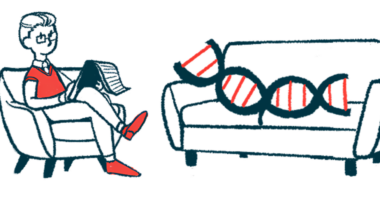Concizumab reduces bleeding in patients without inhibitors
Hemophilia A, B patients in study saw significantly fewer episodes

Adults and adolescents with hemophilia A or hemophilia B without inhibitors experienced significantly fewer bleeding episodes when using concizumab as a prophylactic (preventive) treatment compared with those who weren’t on any prophylaxis.
That’s according to data from explorer8 (NCT04082429), an ongoing Phase 3 clinical study in which Novo Nordisk’s concizumab, delivered daily under the skin for at least 32 weeks (seven months) using an injector pen reduced mean annualized bleeding rates by 86% in patients with hemophilia A and by 79% in those with hemophilia B.
The data are consistent with that from explorer7 (NCT04083781), where concizumab reduced bleeding rates by 86% in patients with hemophilia A or B with inhibitors — neutralizing antibodies that could limit the efficacy of standard treatment — who were previously treated on demand with bypassing agents.
This benefit served as the basis for concizumab’s approval in Canada, under the brand name Alhemo, as prophylaxis for both hemophilia A and B in patients ages 12 and older who have inhibitors. It also supported an advisory committee’s positive opinion on the use of concizumab for the same indication in Europe.
The company-sponsored study, “Concizumab prophylaxis in people with haemophilia A or haemophilia B without inhibitors (explorer8): a prospective, multicentre, open-label, randomised, phase 3a trial,” was published in The Lancet Haematology.
Unmet needs
Hemophilia is a genetic disease in which the blood doesn’t clot properly because a clotting factor is either faulty or missing, resulting in excessive bleeding and bruising. In hemophilia A, the faulty or missing clotting factor is factor VIII (FVIII) and in hemophilia B, it is factor IX (FIX).
Standard treatments, which replace the factor needed for the blood to clot, work well for most patients, but there are still unmet needs for those who develop inhibitors against the provided version of FVII or FIX, calling for non-factor treatment options.
Concizumab is an antibody that binds and inhibits tissue factor pathway inhibitor (TFPI), an anti-clotting protein that normally interferes with the initial steps leading to thrombin production. Thrombin is an enzyme that causes the blood to clot, preventing bleeding. By blocking TFPI, concizumab is expected to promote thrombin production and enhance blood clotting.
The explorer8 study involved men and boys ages 12 and older with hemophilia A or B who were on replacement treatment within 24 weeks before screening. After a pause due to non-fatal blood clots that arose in three patients, the study resumed, with concizumab given as a loading dose of 1 mg/kg, followed by daily doses of 0.2 mg/kg.
Patients were randomly assigned to either daily prophylaxis with concizumab for at least 32 weeks, or no prophylaxis. After completion of the main part of the study, all patients were offered the option to enter an extension study in which they can receive concizumab for up to an additional 265 weeks (five years).
Two additional groups involved patients from the Phase 2 explorer5 study (NCT03196297) who had enrolled before the pause, or those who had received previous prophylaxis with a clotting factor concentrate or on-demand treatment in a non-interventional study called explorer6 (NCT03741881).
Bleeding rates lowered
The study’s main aim goal was to compare the annualized bleeding rates — the number of bleeding episodes adjusted to a one-year time window — for concizumab versus no prophylaxis in both types of hemophilia.
Over two years, 173 patients were screened, and 148 were enrolled in one of the four groups.
For patients with hemophilia A, prophylaxis with concizumab reduced the annualized bleeding rate for spontaneous and traumatic bleeding episodes by a mean of 86%; for those with hemophilia B, the reduction was of 79%.
The most common side effects were infection with the COVID-19-causing virus (13%), increased D-dimers, small protein fragments present in the blood after a clot breaks down (8%), and upper respiratory tract infection (7%).
One patient with hemophilia A died from abdominal bleeding. This was potentially treatment-related, but complicated by high blood pressure. No new blood clot events were reported after the study resumed.
“Daily, subcutaneous concizumab prophylaxis was efficacious in reducing the bleeding rate and was considered safe in patients with haemophilia A or B,” the researchers wrote. The data, they wrote, “establish its potential to be one of the first subcutaneous treatment options for patients with haemophilia B,” who have fewer treatment options available.








